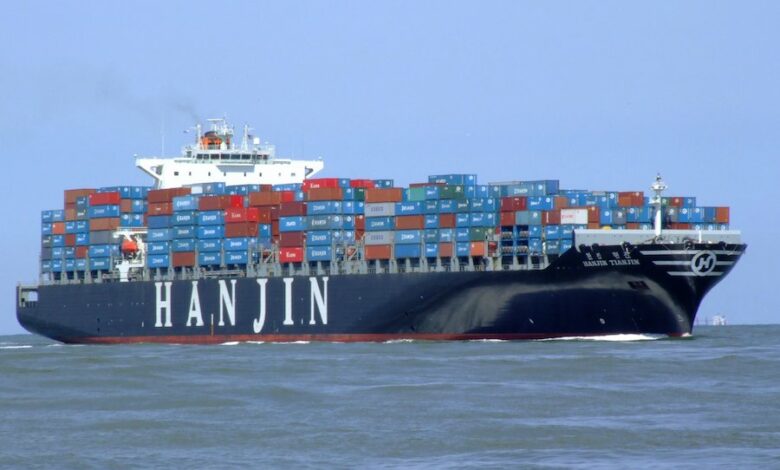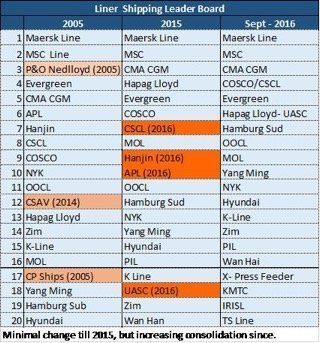Hanjin’s demise, commoditisation and a missed opportunity

Mahim Khanna, a regional director with Dutch firm TBA, has his say.
This year will go down as the year of change in liner shipping, ultra large containerships have been a catalyst for the largest shake up and positive consolidation in the industry. The scalpel has so far fallen on three of the top ten lines of 2015. If we include, UASC (No 18), 11.7% of global teu capacity is affected.
Over the years, liner shipping has become increasingly commoditised. The lines have focused on economies of scale and lower cost, but overall carriers were unable to offer any real differentiation. Countless studies have highlighted commoditisation as the bane of container shipping. Bain Consulting referred to it as “a commoditization stalemate… even in the record earning year of 2010, carriers with higher service levels did not outperform the industry financially because they were not compensated for the higher costs and better value.”
Dr. Martin Stopford speaking at TPM in 2015 asked “whether carriers [will] fulfill the promise of containerisation?”
Hanjin’s disorderly demise will make a huge dent in this ever increasing commoditisation.
Share market volatility is often driven by greed and fear, but when fear strikes, it is panic stations and dramatic. How will the manner of Hanjin’s exit will affect global trade, when all participants are accustomed to a standard, no issues, port-to-port service? How will trade and logistic managers’ respond? Will it hasten the exit of some other lines? Is anyone bold enough to predict what the leaderboard will look like by 2018?

Will mindsets change and focus on differentiation?
Perhaps more important than just more consolidation is whether the lines and their customers are willing or able to change their mindsets?
For the lines, there is now an opportunity to highlight differences in the current risky climate along with working on extending their product beyond the standardised product. NVOCCs have shown the way and new technology provides many opportunities.
It was 1986 whent Peter Drucker in his authoritative work The Frontiers of Management argued that logistics was one of the last frontiers for top management, but alas, over the years, often we have seen shipping and related logistics become more of a procurement exercise focused on the lowest cost of the standardised commodity.
Shipping demand and supply fundamentals will remain skewed for the next two years, (lines may go under, but vessels will mostly remain afloat) it will take some resolve from the lines to turn container shipping into a sustainable business and fulfill the promise of containerisation. Potentially this can benefit not only the shipping lines but all industry participants be it port, terminal, freight and related industries.
In all the hardship to the trading community with reportedly $14bn of cargoes affected, we need to spare a thought for Hanjin’s staff and vessel crew. Indeed, all the hard working ordinary shipping lines’ staff around the world have deserved better than what the industry has seen in the last few years.

I, find your article bit short sighted, I been in global container business for 20 years, and bringing in bigger ships was huge mistake, because no one international port can quite handle these huge capacity ships, but these port are being forced to adjust to it, and some go in debt or out of business because of it. #2, All The Giants Owners from Maersk, CMA/CGM, COSCO China, Hapag-Lloyd, and So on down the list are Heavily into Financial debt from $4.1B for #7 Hanjin, to $10B for #1 Maersk. The reason why Companies like Maersk & MSC, put these Alliance together, Is to curb cost control, but that really has not help at all. Maersk and MSC, Have had alliance, for over a year and Not made any money together. Each Carrier keep building larger ships, to what competing against each other or its competitors, Who now are also matching them in size, So that idea didn’t not work either, and bigger is not better. I for see Maersk In the future heading into demise world, Splitting their company in half, Is too little too late, Their most profitable division is Petro market, Maersk has huge market their, everyone need fuel, so that division they should concentrate on, and let the container side be split evenly between six other companies. You will never find 100% of ship owners agreeing on anything long enough to stop ordering “New Ships”, and Banks are the worst of this group, As long as the world banks keep throwing money at ship Owners the Fifty, (50%) will keep ordering, while Fifty, (50% ) others keep scraping them, right now as I speak you have hundred and hundred of ships parked, with Crews and Without crews, because of No cargoes, or company is out of business, so you have crap shoot here: “STOP BUILDING SHIPS FOR 5 YEARS” and Let the market fix itself, and keep banks, and ship owners in the closet, and this will fix itself, otherwise this mess will be here for a long, long time, your choice!.